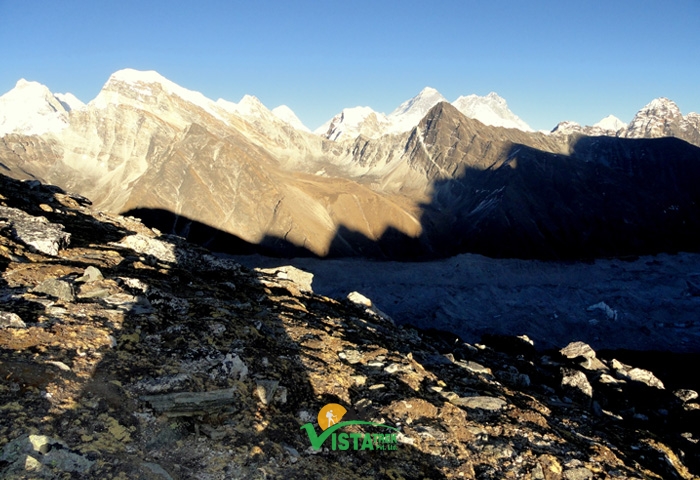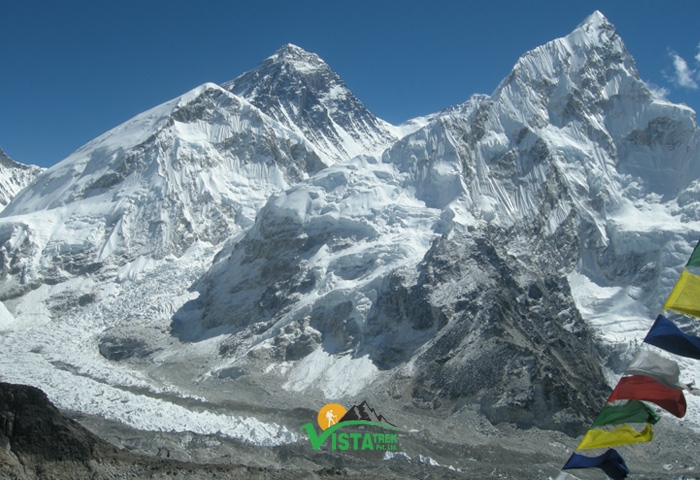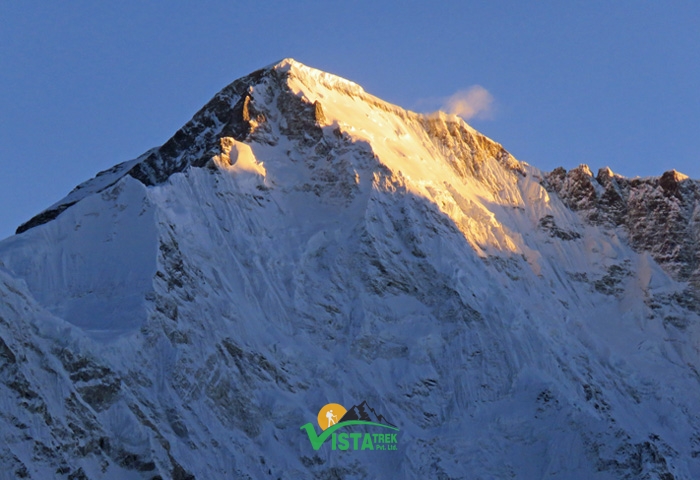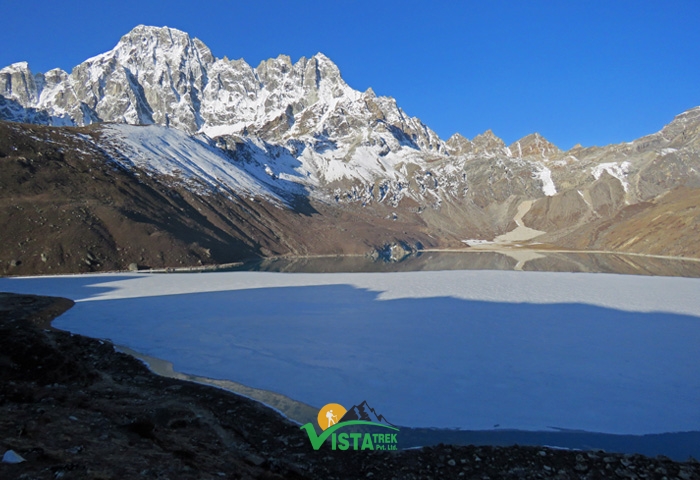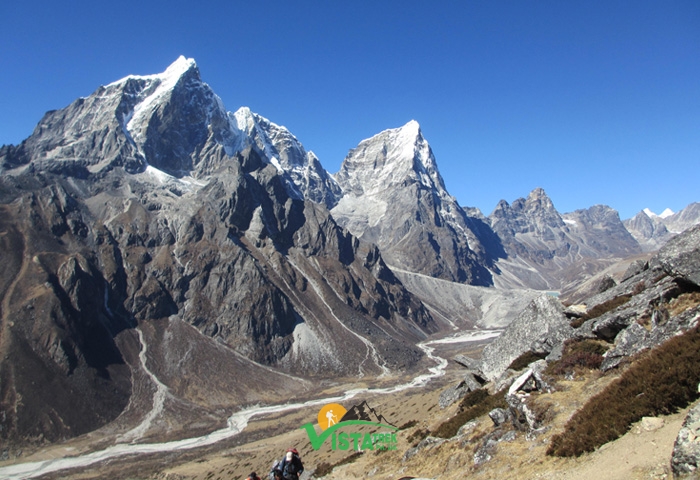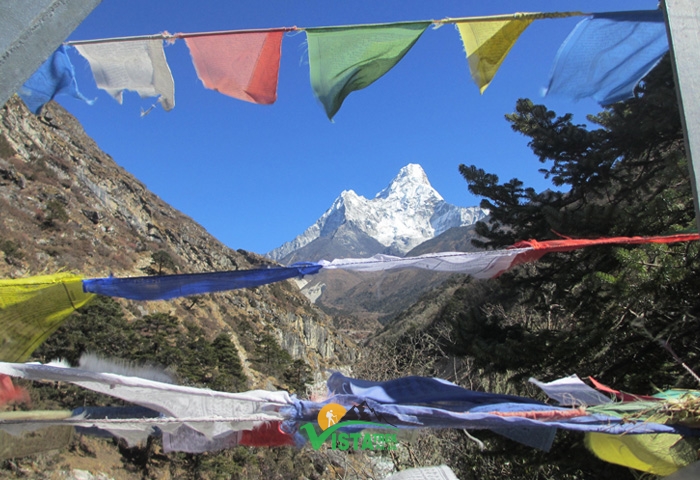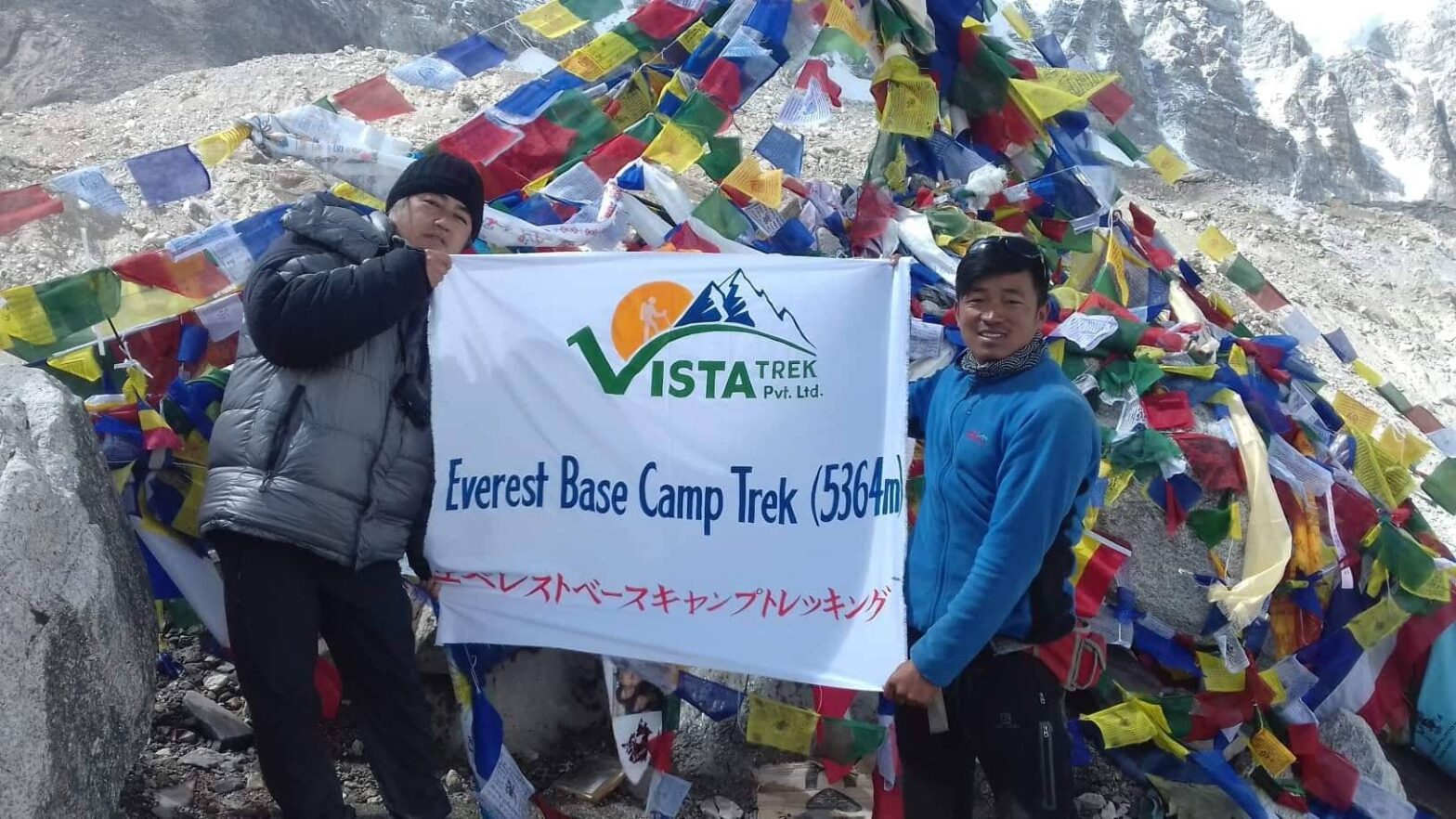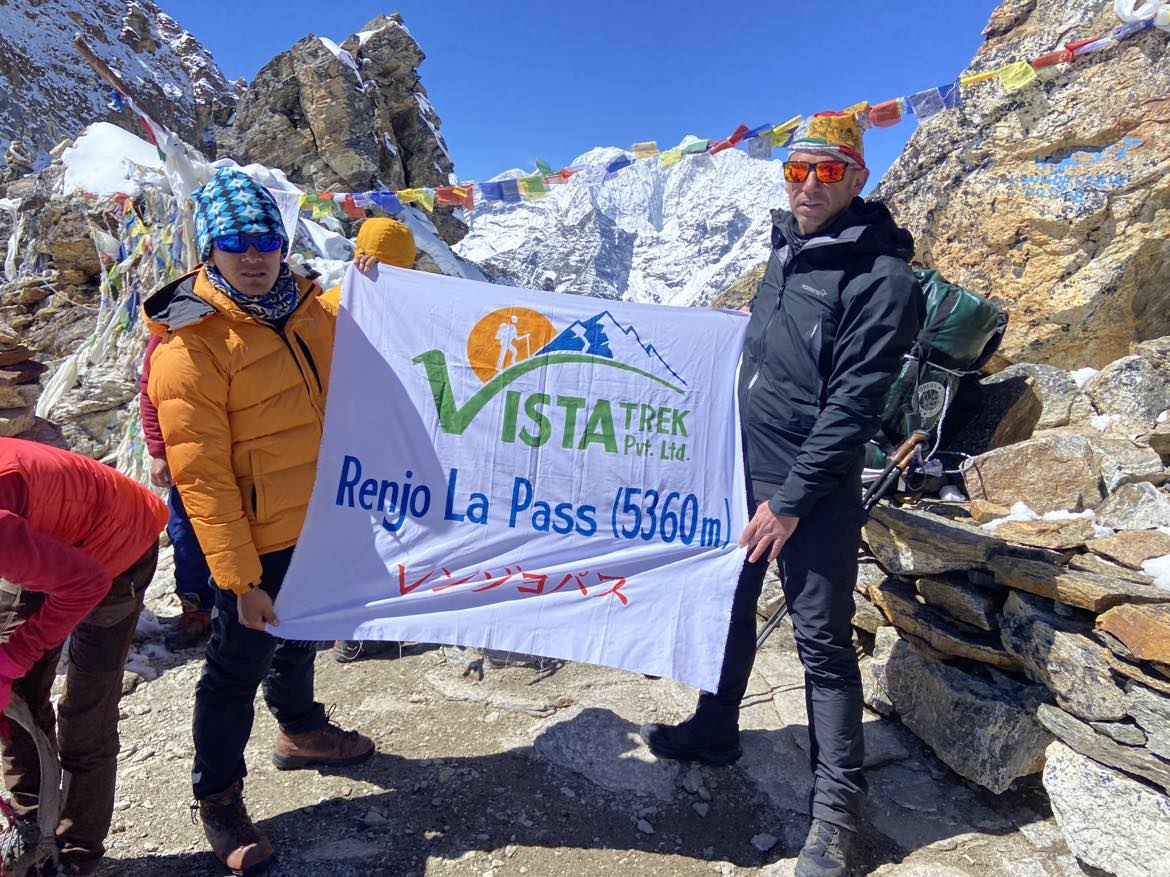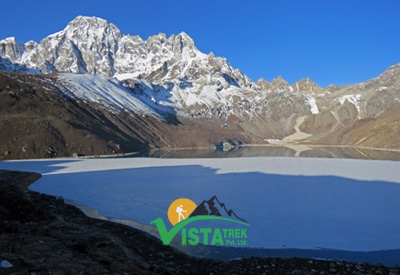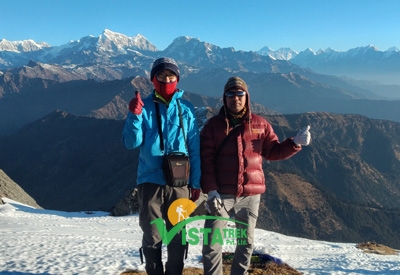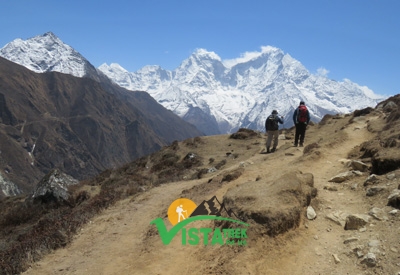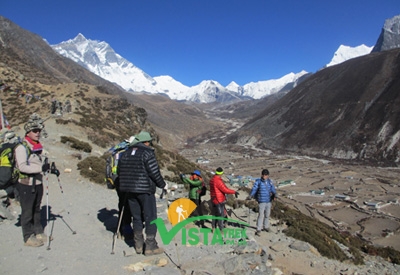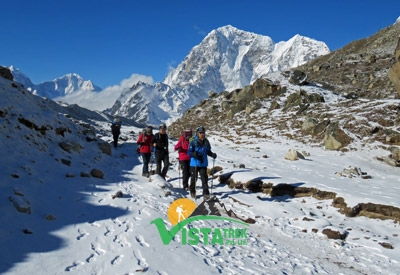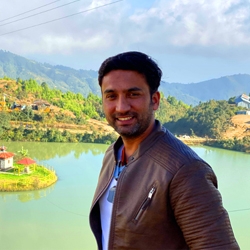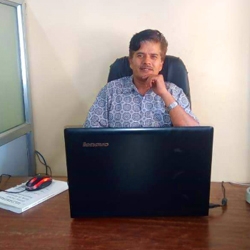Trip Facts
- Duration 17 Days
- Start FromKathmandu
- Group Size1-10 Pax
- End FromKathmandu
- Trip GradeModerate to Strenuous
- Max Height 5550 m
- AccommodationTea House
Best Season
Sept – Nov, March – May
Trip Highlights
- Enjoy the views of the Everest Himalayas including the Mt. Everest (8848m)
- Relish the culture and traditions of the Sherpa ethnic community
- Surreal scenery of the Gokyo Lakes and rich biodiversity along the trail
Trip Overview
The EBC Gokyo Lake Trekking is an exciting trip that combines the best of the Everest region. Along with the Himalayas and Sherpa culture, this trip includes another great destination, the Gokyo Lakes. Moreover, the trekkers can also enjoy the riches in the Sagarmatha National Park. Also, the views of mountains like the Mt. Everest (8848m), Lhotse (8516m), Cho Oyu (8201m), and Ama Dablam (6856m) decorate the scenery for the entire trip.
Firstly, the EBC Gokyo Trekking begins with a surreal flight from Kathmandu to Lukla. A short and scenic trek takes you to Phakding and continues to Namche Bazaar. On the way, you will also enter the Sagarmatha National Park and enjoy its beauty. After spending a day at Namche, you will trek alongside the Imja River to reach Tengboche. The village also houses the glorious Dawa Choeling Monastery in the backdrop of Mt. Ama Dablam (6856m). Then, you trek to Dingboche where you spend another day to acclimatize. Further, a trek along the Khumbu Glacier will bring you to Gorakshep. A short trek across the dry rigid trails will lead you to the Everest Base Camp. The base camp is surrounded by Khumbu Icefall, Khumbu Glacier, and many majestic Himalayas.
After returning from the base camp, you will hike to the top of the Kala Patthar viewpoint. Then, you will leave the EBC trail and head west to Dzongla. Next, a difficult climb takes you to the top of the Cho La Pass (5420m). After relishing the views of the Himalayas in the Everest ranges, you will descend to Gokyo village. As the trip reaches its final sections, you will descend along the Bhote Koshi River to reach Khumjung. Finally, after exploring the local museum, you descend to Lukla and conclude the trip with a flight to Kathmandu.
Note:
EBC-Chola Pass-Gokyo Lake Trek is suitable for expereinced and physically fit person. We have many other trips for beginner. Please kindly contact us for customized itinerary.
Trip Itinerary
- Upon arrival at Tribhuwan Intl Airport in Kathmandu, a representative from Vista Trek waiting, well in time, to receive you shall welcome you to this land of towering Himalayas. Once reaching your hotel in a car from the airport, all you need to do is check in and enjoy the refreshment served.
- We then visit the Vista Trek office for discussion on trekking, introduction to the guide and porter and settlement of dues if any. Since you will still have some time left for a walk around Thamel, you can do so if you please.
- We fly to Lukla from Kathmandu in the morning. This 30-minute flight comes with spectacular views of the hills and the Himalayas, forcing many to take their cameras out or simply use their mobile phones with attempts to capturing the beauty.
- We walk to Phakding Village for 3 to 4 hours after breakfast in Lukla. The trail is relatively comfortable and passes through four Sherpa villages. Houses with stone walls and colourful roofs, huge prayer stones with mantras from the teachings of Buddha carved in them, monasteries with busy budding Lamas, several mountains already in sight and rivers and waterfalls along the way, the trail already offers us a glimpse of what to expect.
- Once in Phakding, one thing we can do is walk around the village or just relax on a bench in the porch of the hotel and absorb as much as we can after lunch.
- Spend the night in a hotel.
- After breakfast, we walk for about 2 hours to Jorsalle Village for lunch. The route starts along the banks of Dudhkoshi River and crosses two suspension bridges before reaching Monjo Village. A 20-minute descent towards the end, finally, leads to Jorsalle Village, the entrance to the Sagarmatha National Park as well as the last village until Namche Bazaar.
- After lunch, we walk for around 3 hours to Namche Bazaar. With the raging Dudhkoshi River mostly to the left for about half an hour before crossing a suspension bridge, the trail in its final 2 hours ascends through a pine forest. In reaching Namche, the administrative headquarter of the Khumbu Region, the ascent often demands a little extra even from seasoned legs.
- Spend the night in a hotel in Namche.
- It’s time for a trip to Sagarmatha National Park Museum after breakfast. Most people use their time at the Museum trying to gain some insight into the Everest Region – about the highest peaks, animals and vegetation that rule the region as well as the Sherpa culture and experiences of many trekkers and climbers.
- We then leave the Museum and walk for about an hour to the Everest View Hotel for lunch. Constructed on a site in an altitude higher than any other on earth and ideally positioned, the hotel presents all its guests with ample individual space to appreciate the grandeur – a typical Sherpa village in the Khumjung Valley below to the North-West; on a hilltop above the village, the Khumjung Monastery, where a preserved skull which the locals believe to be that of a Yeti can be witnessed upon request; Mt Khumbila, a massive rocky elevation worshiped as a deity by the locals and, thereby, a restricted peak for climbing, right above the valley; and to the North, captivating views of the Himalayas, including Mt Everest, Mt Lhotse and the beautiful Ama Dablem.
- After climbing down to Namche Bazaar in the afternoon, a walk around the Bazaar is a preferred involvement to some and indulgence to others.
- Spend the night in the hotel.
- We start trek after breakfast and stop at Thanga for lunch after about 3 hours’ walk. The comfort of the trail up to Kyangzuma Village ends with the moderately challenging descent to Thanga. In Thanga, a pretty small settlement with three constructions at most, the trek stops for lunch in a teahouse. While the food is prepared, many people find waiting an experience of its own – the rumbling of Dudkhoshi River from the deep gorge below reaching the eardrums from the right, the eyes exploring the presence of the pine and rhododendron trees densely populated in the area, a gentle breeze caressing the hair while waiting for lunch hungry after several hours of walk.
- After lunch, we walk for around 3 hours to Tyangboche. From here on, the trail ascends sharply mostly through forests filled with pine and rhododendron trees all the way to Tyangboche. A spectacular view of the beautiful Mt Ama Dablam meets the eyes as soon as they enter the village. The next to capture the attention is the biggest monastery in the Khumbu Region, the Tyanboche Monastry. The settlement presents a typical picture of a village in the laps of the Himalayas – houses made of stones in a cluster separated by narrow alleyways, a monastery and/or a temple highlighting the beliefs of the people, people going about displaying a simple way of life, a forest nearby, a river flowing pretty close and between two the snow caped Himalayas.
- Spend the night in a hotel in Tyangboche.
- After breakfast, we walk for about 3 hours to Pangboche Village for lunch. With a downhill to the village of Diboche before a long gradual ascent, through a rhododendron forest, across a bridge, the trail finally brings its travelers to Pangboche Village. With narrow footpaths carved along the edges of hilltops, parts of the route demand alertness while being constantly drawn by the breathtaking views on offer in front, now that Mt Ama Dablam gets closer and closer with every step forward.
- After lunch in Pangboche, we start walking again for about 3 hours to Dingboche. With the magnificent Mt Ama Dablam to the right all the time, this course triggers some contemplation into the phenomena in the immediate environment along the way – yaks with loads on their backs walking in a file, a tahr jumping care freely on slopes only perhaps the most daring would think of giving a shot at and a male impeyan pheasant – the national bird of Nepal – dancing with a hope to impressing a female nearby who till now seems to simply be turning a blind eye … a smile and a gentle shake of the head in sincere appreciation of the visually appealing yet intellectually challenging ways of things. Dingboche, with around forty households, is home to approximately two hundred locals.
- Spend the night in a hotel in Dingboche,
- After breakfast, we pack our lunch and go up a steep climb for around three hours to Nangkar Tshang at an altitude of 5,616 metres. From this vantage point, the view when facing Norht includes Mt Lothse and Mt Nuptse in the front, Lotse Shar and Peak 38 and Island Peak to the front-right, Mt Ama Dablum to the right, Mt Thamsherku, Mt Kantega and Taboche Peak to the back and Chola Tse Peak and Lobuche Peak to the left.
- After spending some time in Nangkar Tshang, we come back to Dingboche and spend the night here.
- After breakfast, we walk for about 4 to 5 hours to Lobuche Village. A steep climb most of the way, the trail starts out of Dingboche, past a chorten, ascending to Dugla at the end of the terminal moraine of Khumbu Glacier … climbing steeply to Chukpo Lari past a line of memorials commemorating climbers who have lost their lives in Everest, and, finally, easing off for the last 20 minutes or so. Sensing the approaching destination, the legs, which have otherwise almost given up to the demands of the walk, gather all they’ve got with this newly found enthusiasm. After lunch, Lobuche, a tiny hamlet with a few teahouses, welcomes its visitors to either investigate the ridge on the opposite side of the Khumbu Glacier or watch the fascinating changes in colour the sunset brings on almost the top half of Mt Nuptse.
- Spend the night in a teahouse in this settlement.
- After breakfast, we walk for about 3 hours to Gorakshep. After a three-hour climb to Lobuche Pass on rocky paths and under windy conditions followed by a brief stop for a cup of tea, the trek stops at Gorakshep for accommodation arrangements and lunch.
- After lunch, we start walking again for 2 hours to Everest Base Camp. Walking on the lateral moraine of the Khumbu Glacier, audibly making cracking sounds, most manage to push forward up the grueling climb uphill purely on determination as the level of oxygen drops to around 50 % lower to that at the sea level. A stop on the way here for a short while … five of the world’s highest mountains crammed in a small area … fascinating! Ascending the side of the glacial moraine for a couple of more hours before landing on the moraine itself, the trail finally reaches the Everest Base Camp. Photographs, smiles, hugs … in sheer admiration of the endurance to the Base Camp of the highest mountain on earth.
- We walk back to Gorakshep and spend the night.
- We start early morning and walk for almost 2 hours to Kala Pathar. The almost 200-metre climb, taxing by now after several days on the trot, leads to the top of Kala Pathar. A 3600 view of the Khumbu Himalayan range – Mt Everest and Mt Lhotse in the front, Lingtren and Khumbutse Peaks to the front-left, Mt Pumori to the left, Numerous other peaks to the back-left, back and the back-right, Mt Taboche and Cholatse to the right, Mt Nuptse to the front-right.
- After lunch, we start walking to Dzongla. The trail heads back to Lobuche before presenting a new route initially along the slopes of a hill – the way to Dzongla. Chola Tsho, a calm jade-green lake at the foothills of Mt Cholatse, is what attracts anyone traversing this trail. With only a few lodges to offer, Dzongla awaits your arrival on the foothills of Mt Akram Tse with Lobuche Peak in the backdrop.
- Spend the night in Dzongla.
- We start early morning and walk through Chola Pass in about 5 hours. The relative comfort of the trail demands a careful approach once reaching Chola Pass, beautiful, yet, testing, with a potential to be lethal. The steep and slippery traverse through Ngozumpa Glacier (the longest in the Himalayas) asks for that little extra even from the confident. Walking on a glacier, high up in these mountains, is certainly nowhere similar to a walk in the park. Far from it, the expedition demands a careful calculation of the adventure on offer – too afraid, one won’t even try; too lenient, one may never make it back home.
- After Chola Pass, continue walking for another hour and stop at Thaknak. The settlement with hardly half a dozen teahouses is there simply to provide lunch for you.
- After lunch, walk again for 2 ½ hours to Gokyo Village. Along the edge of the mountain to the other side, through Ngozumpa Glacier, on a ridge for a while, the trail finally leads to Gokya Village on the edge of the third as well as the biggest lake of the area – locally known as Dudh Pokhari.
- Spend the night here.
- We wake up early in the morning and walk uphill for 2 ½ hours to Gokyo Ri. This almost 600-metre climb is relatively challenging. Surrounded by the Himalayas, for many, the view from the top of Gokyo Ri – more than 40 massive structures including Mt Everest, Mt Choyu, Mt Lhotse and Mt Makalu, all above 8000 metres, piercing the clouds – is a moment for contemplation. An additional bonus on a clear day is to witness sunrise from 5,357 metres.
- We spend some time capturing this moment before strolling back to Gokyo Village for breakfast.
- We then leave for Machhermo, reaching the place right on time for lunch. A typical village, similar to the ones found in the region, Machhermo lies in the Dudh Koshi Valley south of Gokyo and just below the terminal moraine of the Ngozumpa Glacier.
- Spend the night in a hotel in Machhermo.
- After breakfast, we walk for around 4 hours to Phortse Tenga. Mt. Thamsherku, Mt Khangtega, Mt Tawache andMt Cholatse among others still magnificently in sight, the sharp descent takes everyone past waterfalls that are frozen in the winter and refuges that the Sherpas use when bringing yaks to higher pastures in the summer, before, finally, arriving in Phortse Tenga, the stopover for lunch.
- After lunch, we start walking again for an hour and a half to Khumjung Village. Up for an hour until Mongla, a gentle stroll downhill and a climb up again, albeit for a short distance, the travel brings everyone into the Khumjung Village - a typical Sherpa village in the Khumjung Valley. The Khumjung Monastery, where a preserved skull which the locals believe to be that of a Yeti can be witnessed upon request, on a hilltop above the villageand the Hillary Schoolestablished by Sir Edmund Hillary himself are places worth a visit.
- After breakfast, we start our return journey with a walk to Namche Bazaar via Syangboche airstrip at the highest altitude on earth. Crossing Namche in just about an hour, this almost 5-hour trail heads further down to Monjo, our stopover for lunch.
- After lunch, we walk again for about 3 hours to Phakding Village, the stopover for this day.
- We leave Namche Bazaar after breakfast and stop at Phakding Village for lunch after about 4 hours.
- We walk the next 4 hours (approximately) to Lukla.
- Spend the night in a hotel in Lukla.
- We fly back to Kathmandu and reach the hotel in time for lunch. The afternoon is for shopping for some, for buying souvenirs for others and for doing whatever they please for still others. In the evening, however, please allow us the pleasure of your company during the fare-well dinner organized by Vista Trek.
- Spend the night in the hotel.
- If you have a morning flight, we leave for Tribhuwan Intl Airport early morning in a car arranged by the office.
- If your flight is in the late afternoon or evening, only your WILL shall dictate your involvement or indulgence as you may please before leaving for Tribhuwan Intl Airport in the vehicle.
Cost Includes
- Pick up and transfer by car from Airport-Hotel-Airport.
- 2 nights standard hotel accommodation in Kathmandu.
- Breakfast, lunch and dinner during the trek .
- Local lodges accommodation during the trek.
- Government licensed guides,plus experience porters (including food, salary, accommodation, equipment, medicine & insurance).
- All local transportation including flight tickets to and from Lukla.
- All necessary permits and entry fees.
- All government taxes.
- Medical kit box.
- Rescue assistance.
- Necessary equipment (sleeping bags, down jackets etc. if needed).
- Our service charge.
Cost Excludes
- Meals in Kathmandu.
- International airfare.
- Nepal entry visa fee ($40).
- Your travel insurance (should include your medical and rescue).
- Any personal expenses like hot shower and battery charges in the mountain.
- Any kind of hot and cold drinks.
- Staff & driver tipping.
Trip Map
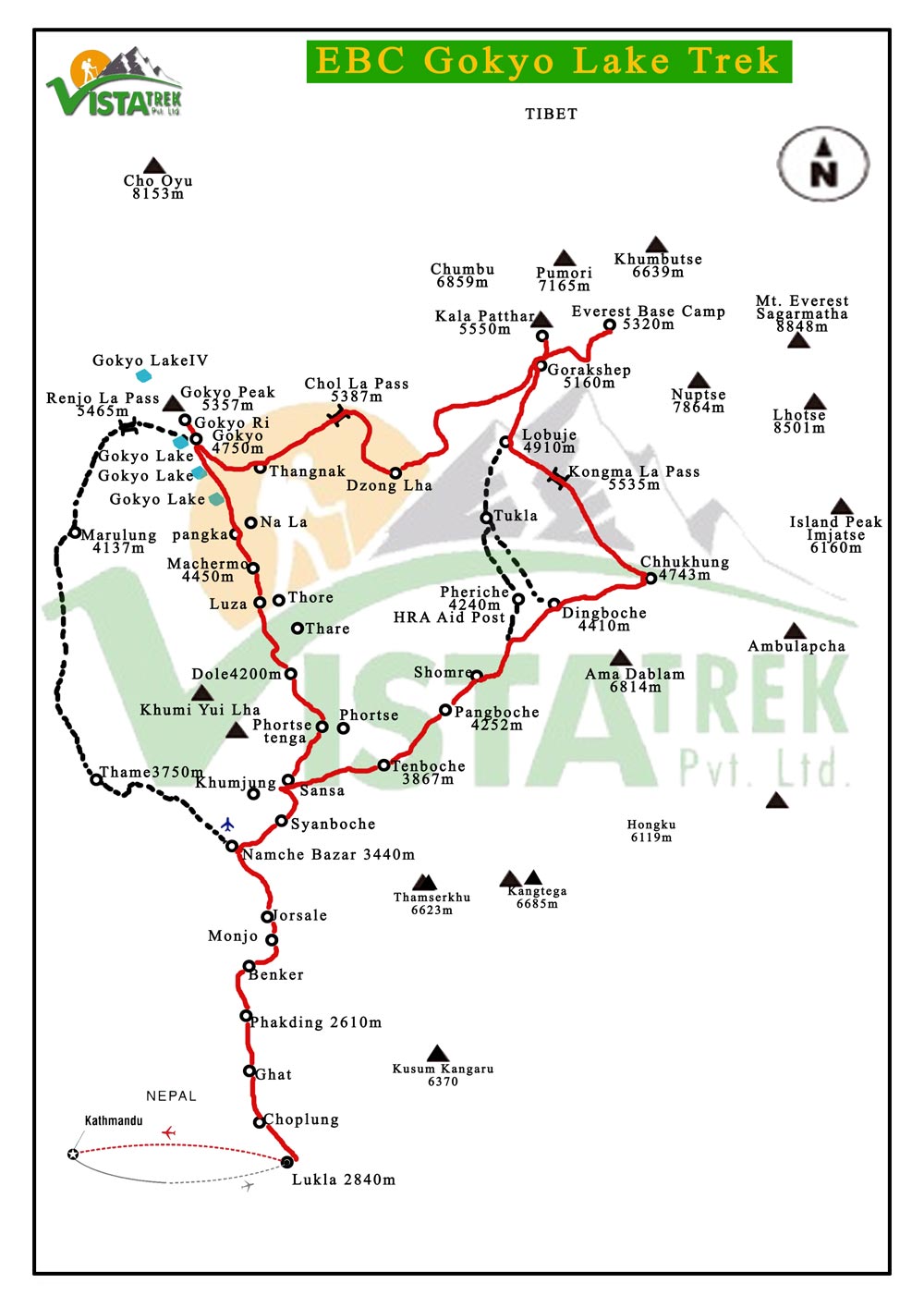
Useful Info
About Accommodation .
In Kathmandu, we will accommodate you at “Hotel Sapana Garden” a Deluxe hotel situated in Thamel , and at local lodges during the trek on twin sharing basis. Hotel in Kathmandu comes with private bathroom , however in mountain, toilet and shower will be on sharing basis. In the busy months, (October/November & April/ May) you may have to share the room with other traveler as some villages have limited number of local lodges .
About Meal
We offer typical Nepali meal as well as continental, Tibeten and Indian meal at tea houses. The menu of tea houses include traditional Nepali Dal Bhat set which consists rice, lentil soup , pickle and vegetable curry. Other meals available are toast, boiled eggs, pancake, omelets, local bread, fried rice, Fried noodle (Chow mein), fried potato, noodle soup, momo (Nepali Dumpling), vegetarian curries, macaroni and pizza . You can even get meat item, however meat is not fresh and hygienic in the mountain, so We highly recommend to take vegetarian meal. For vegetarian or vegan, do not worry about it, Nepal is such an easy place for vegetarians.
About Staff:
A Guide assist you from Kathmandu to Kathmandu. In a group with more than 8 clients, 2 guide will be provided. Porter will join in Lukla. A porter provided for 2 trekkers, and carries between 15 to 20 K.G.
About Equipments
Following Equipment list is recommended to bring for EBC-Chola Pass-Gokyo Lake Trek.
Down Sleeping Bag, Down Jacket, Long sleeved shirt, Jumper or fleecy jacket, T – shirts, Trekking shoes or boots, Comfy shoes for around the camp, thick and warm woolen socks, Light cotton socks , A day bag to carry your valuable, Sun hat, Woolen hat, Gloves, rain coat, Sun block, lip balm , Goggles or sunglasses, Long underwear, Thermal wear, Nylon windbreaker, Nylon wind pants, Water bottle, Sewing kit, Medical & first aid kit, Flash light, Batteries and bulbs, Swiss army knife, Towel and toiletries etc. Please kindly check our Equipment list for details.
About Temperature.
Temperatures vary as per the elevation and season in Everest. Spring (March to May) and Autumn (September to December) is quite warm below 3000m that you can walk with t-shirts and shorts during day. Above Namche, day time temperature is around 5-10 °C and night time temperature is below 0 °C. Everest Base Camp is cold through out a year and night time temperature can reach up to–25 °C in winter. There are no heating system inside the room in guest houses, therefore it is important to prepare warm clothes and sleeping bag for the trek.
Physical Fitness and experience
EBC-Chola Pass-Gokyo Lake Trek is a Challenging and high altituide trek which is fit for those who has the ability to walk 5-6 hours ups and downs in a day carrying own day bag. Some days are even longer with 7- 8 hours of walking, which demands more physical fitness.Therefore it is better to do some training prior to trek.We suggest you to start hiking or long walk at least once a week 10-12 weeks prior to trek. Carrying your day bag, you should walk for 5-6 hours ups and down to improve your strength. If you don’t have mountain or hills for hiking, running or doing some Cardio training at Gym also work.Past experience is helpful but no technical skill is needed. If you are taking medicine for heart, lung or for blood diseases, please kindly consult your doctor and inform to Vista Trek P. Ltd.
About Insurance
You have to obtain the travel insurance which should cover emergency evacuation and medical expenses. Some Insurance policy’s cover only up to 4000 meter, so please kindly confirm with the insurance company before your purchase it.
About Seasons
Spring (March to May) and Autumn (September to November) are the best months for EBC-Chola Pass-Gokyo Lake Trek. Winter (December to February ) is not suitable for this trek as the temperature is extremly cold and Chola Pass is also cover by heavy snow.
About Lukla Flight
It is very difficult to predict the weather in mountain. Because of bad weather, the flight between Kathmandu to Lukla may be delayed or canceled for a day or more. Due to the weather changes in Himalaya, we can face such problem even in good season. So we would like to request you to add few days extra in Kathmandu. If you complete your trip smoothly, then you can enjoy your time with other activities like sightseeing, White water rafting. Jungle activities or more.
If your flight is cancelled in Kathmandu then we will re-book the flight for the next day. There may be an option to use private helicopter paying additional from $300 to $500 We may also be able to provide an option for a privately chartered helicopter. When flight is cancelled , we will arrange you a hotel however food and accommodation is not cover in the package. Same process will be applied if the flight cancelled or delayed in Lukla.
Please cheque our FAQs for various issues of the trek


 +977 9841322985
+977 9841322985 

